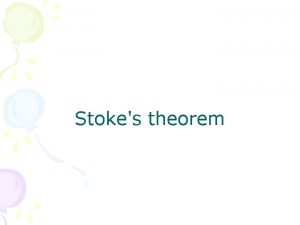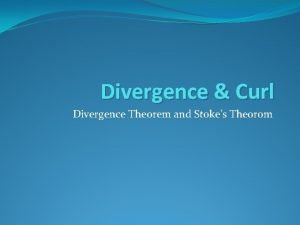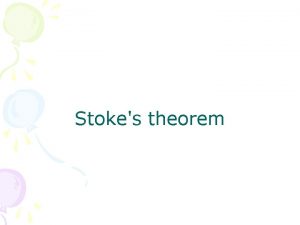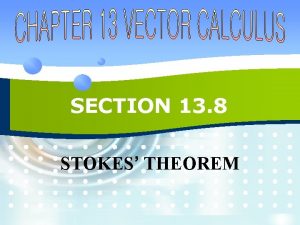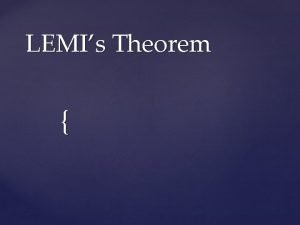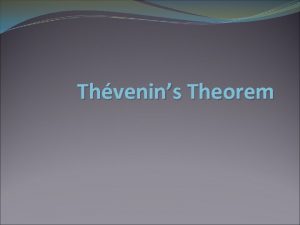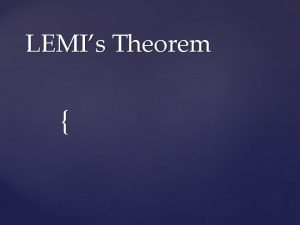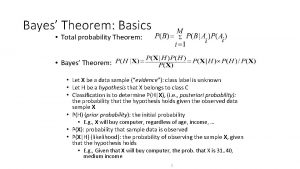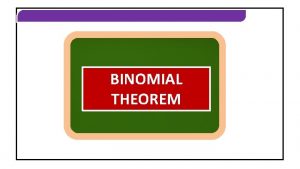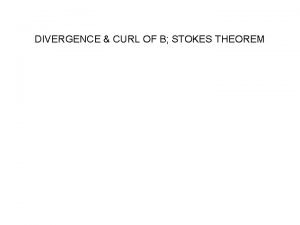Stokes theorem Topics of discussion History Definition of














- Slides: 14

Stoke's theorem

Topics of discussion • History • Definition of Stoke’s Theorem • Mathematical expression • Proof of theorem • Physical significance • Practical applications of Stoke’s Theorem.

STOKES’ THEOREM • The theorem is named after the Irish mathematical physicist Sir George Stokes (1819– 1903). – What we call Stokes’ Theorem was actually discovered by the Scottish physicist Sir William Thomson (1824– 1907, known as Lord Kelvin). – Stokes learned of it in a letter from Thomson in 1850.

Statement of Stoke’s Theorem It states that line integral of a vector field A round any close curve C is equal to the surface integral of the normal component of curl of vector A over an unclosed surface ‘S’.

Mathematical expression ( A. dr= C X A). d. S S Stoke’s theorem thus converts surface integral in to a line integral over any path which constitutes the boundary of the surface.

where is known as Del Operator It is given by =î∂/∂x+ ĵ∂/∂y+ ^∂/∂z k It is treated as a vector in Cartesian coordinate system but it has no meaning unless it is operated upon a scalar or vector.

Y c dr A X o ^ ^ ∆ s 1= k ∆s 1 Z

Proof of theorem In order to prove this theorem, we consider that surface ‘S’ is divided in to infinitesimally small surface elements ∆S 1, ∆S 2, ∆S 3…. . etc, having boundaries C 1, C 2, C 3…etc. Boundary of each element is traced out anti-clock wise. y c ∆S 1 z ^ =k∆S 1 A x

The line integral of a vector field A round the boundary of a unit area in x-y plane is equal to the component of curl A along positive z-direction. Thus the line integral of a vector field A along the boundary of ith surface is equal to the product of the curl A and normal component of area ∆Si i. e. ^ ∫A. dr =(Curl A). k∆S =( i ^ XA). k∆Si c A similar process is applied to the surface element, tracing them all in the same sense then above equation holds good for each surface element and if we add all such equations , we have n n ∑∫ A. dr=∑( i=1 X A). K∆Sii . . . (1)

Then all the integrals within the interior of surface cancel, because the two integrals are in opposite directions along the common side between two adjacent area elements. The only portions of the line integrals that are left are those along the sides which lie on the boundary C.

Then equation can be written as N Lt ∑( N ∞ S 0 i ^ . A). k∆S = ∫∫( i=1 I ^ X A). kd. S s Hence the equations(1)reduces to ∫A. dr=∫∫( ^ XA). kd. S c This is the Stoke’s Theorem for a plane surface.

Physical significance • If ∫ A. dl =0 for any closed path, then A is called irrotational or conservative field. • If A denotes the force F then ∫F. dr=0 means that total work done by the force in taking a body round a closed curve is zero i. e total energy remains conserved throughout the motion.

Practical applications • It is used for determining whether a vector field is conservative or not. • It allows one to interpret the curl of vector field as measure of swirling about an axis.

 Green's theorem is a special case of
Green's theorem is a special case of Stokes theorem physical significance
Stokes theorem physical significance Stokes' theorem
Stokes' theorem Stokes theorem
Stokes theorem Flux density formula
Flux density formula Stokes theorem lamar
Stokes theorem lamar Stokes theorem
Stokes theorem Verify stokes' theorem examples
Verify stokes' theorem examples Customer service topics for discussion
Customer service topics for discussion Panel discussion meaning in tamil
Panel discussion meaning in tamil Enlightenment salon party answers
Enlightenment salon party answers Group discussion vs debate
Group discussion vs debate What is a gd
What is a gd Prerequisites of a group discussion
Prerequisites of a group discussion Finance topics for discussion
Finance topics for discussion

